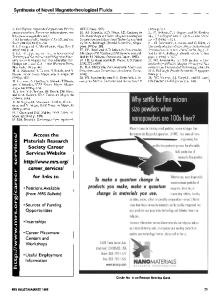Behavior of Magnetorheological Fluids
- PDF / 1,377,111 Bytes
- 4 Pages / 576 x 777.6 pts Page_size
- 80 Downloads / 306 Views
Magnetorheological Fluids John M. Ginder
Introduction In the absence of an applied magnetic field, magnetorheological (MR) fluids typically behave as nearly ideal Newtonian liquids. The application of a magnetic field induces magnetic dipole and multipole moments on each particle. The anisotropic magnetic forces between pairs of particles promote the head-to-tail alignment of the moments and draws the particles into proximity.1 These attractive interparticle forces lead to the formation of chains, columns, or more complicated networks of particles aligned with the direction of the magnetic field. When these structures are deformed mechanically, magnetic restoring forces tend to oppose the deformation. Substantial fielddependent enhancements of the rheological properties of these materials result, as demonstrated in Figure 1. The myriad potential applications of MR and electrorheological (ER) fluids provide considerable motivation for research on these materials. The availability of fluids with yield stresses or apparent viscosities that are controllable over many orders of magnitude by applied fields enables the construction of electromechanical devices that are engaged and controlled by electrical signals and that require few or no moving parts. Potential automotive applications2 include electrically engaged clutches for vehicle powertrains and engine accessories as well as semiactive shock absorbers that can adapt in real time to changing road conditions. Semiactive dampers for rotorcraft control surfaces are among the potential aerospace applications.3 The critical need to mitigate the structural vibrations of large structures has led to the construction of large, high-force MRfluid-based dampers.4 A promising application in manufacturing processes is the computer-aided polishing of preci-
26
sion optics in which abrasive particles are suspended in an MR fluid so that the polishing rate is determined in part by the strength of an applied magnetic field.5 This article highlights recent developments in the understanding of MR phenomena and the development of new MR materials. Substantial progress in understanding the mechanisms of magnetorheology6 and the production of electromechanical devices using MR fluids7 has occurred in this decade. Refer to Phule's article in this issue for the synthesis or composition of practical MR fluids. Rheology Field-dependent rheological properties of MR materials must be measured in order to construct electromechanical devices based on MR fluids or to understand the consequences of interparticle
interactions and structure formation in these materials. This presents an interesting challenge: to devise rheological experiments8 in which the fluid flow is well-characterized and yet in which the applied magnetic field is nearly uniform. Moreover, the high stresses supportable by MR fluids can tax the sensitive but compliant torque sensors of many commercial rotary rheometers. Strong magnetic forces can generate axial or side loads that may lead to or aggravate fixture misalignment.
Data Loading...











